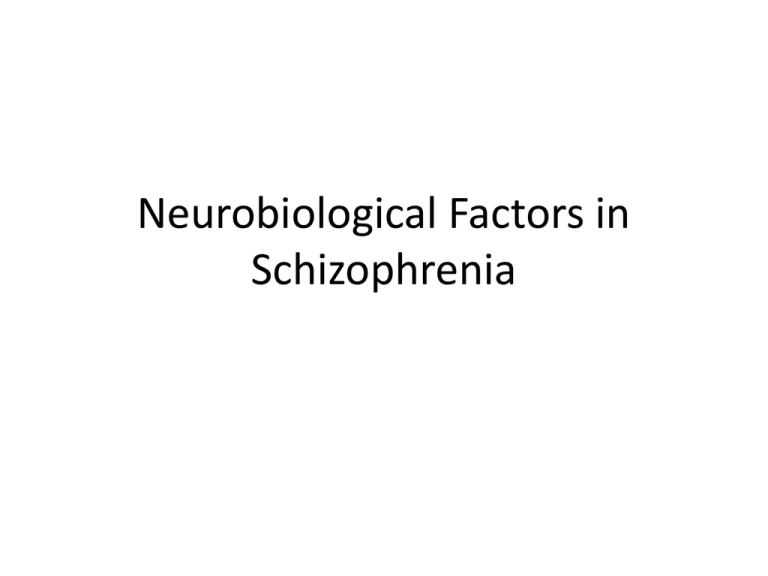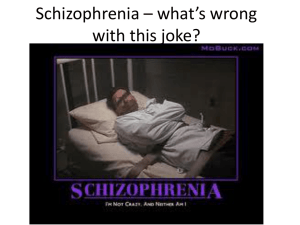Neurobiological Factors in Schizophrenia2013
advertisement

Neurobiological Factors in Schizophrenia Overview • Definition of Schizophrenia: Clinical Features – Component Symptoms – Endophenotype testing • Mechanisms • Etiology of Schizophrenia: Current Evidence – GABA control of network function – Dopamine Hypothesis – NMDA/Network Hypothesis – Genetic and Environmental Factors According to data from the NIMH Epidemiological Catchment Area study, the lifetime prevalence of schizophrenia is: • • • • A. B. C. D. E. 0.01%. 0.1%. 1%. 5%. 10% According to data from the NIMH Epidemiological Catchment Area study, the lifetime prevalence of schizophrenia is: • • • • A. B. C. D. E. 0.01%. 0.1%. 1%. 5%. 10% Which of the following specific populations has the highest prevalence of schizophrenia? • a. Child with one schizophrenic parent • b. Non-twin sibling of a schizophrenic patient • c. Monozygotic twin of a schizophrenic patient • d. Child of two schizophrenic parents • e. Dizygotic twin of a schizophrenic patient Which of the following specific populations has the highest prevalence of schizophrenia? • a. Child with one schizophrenic parent • b. Non-twin sibling of a schizophrenic patient • c. Monozygotic twin of a schizophrenic patient • d. Child of two schizophrenic parents • e. Dizygotic twin of a schizophrenic patient NIMH Schizophrenia afflicts 1% of the general population 10% of people with an immediate family member with the disorder will also develop the disorder Someone with an identical twin with the disorder has a 40-65% chance of developing the disorder The most common eye-tracking movement abnormality in patients with schizophrenia is • inaccurate saccades (hypermetric or hypometric). • impaired initiation of saccades (ocular apraxia). • inappropriate saccades (saccadic intrusions). • impersistence of gaze (large amplitude saccadic intrusions). • abnormal saccadic velocity (slow saccades). The most common eye-tracking movement abnormality in patients with schizophrenia is • inaccurate saccades (hypermetric or hypometric). • impaired initiation of saccades (ocular apraxia). • inappropriate saccades (saccadic intrusions). • impersistence of gaze (large amplitude saccadic intrusions). • abnormal saccadic velocity (slow saccades). Which of the following features is associated with a poor prognosis in patients with schizophrenia? • • • • • a. b. c. d. e. Positive symptoms Married Early age onset Precipitating factors Family history of bipolar disorder Which of the following features is associated with a poor prognosis in patients with schizophrenia? • • • • • a. b. c. d. e. Positive symptoms Married Early age onset Precipitating factors Family history of bipolar disorder Which of the following is NOT a likely characteristic of childhood-onset schizophrenia? • • • • • a. b. c. d. e. Chronic course Unfavorable prognosis Acute onset Hallucinations Delusions Which of the following is NOT a likely characteristic of childhood-onset schizophrenia? • • • • • a. b. c. d. e. Chronic course Unfavorable prognosis Acute onset Hallucinations Delusions Clinical Components of Schizophrenia: Symptom Types • Positive Delusions Halucinations Thought Disorder • Negative Flat Affect Poverty of Thought Loss of Motivation Social Withdrawal • Cognitive Distractability Impaired Working Memory Disruption of Executive Function Early-Onset Schizophrenia: Positive Symptoms: • Hallucinations • Delusions • Disorganized Speech • Disorganized or catatonic behavior Negative Symptoms: • Flattened affect • Anergia (lack of energy) • Alogia (complete lack of speech) • Avolition (lack of motivation) • Social withdrawal Cognitive Symptoms: • Borderline mental retardation Which of the following features characterizes patients with schizophrenia who smoke cigarettes? • • • • • Lower incidence of positive symptoms Less vulnerable to tardive dyskinesia Require more antidepressant medication Require more neuroleptic medication Require more depot neuroleptic medication Which of the following features characterizes patients with schizophrenia who smoke cigarettes? • • • • • Lower incidence of positive symptoms Less vulnerable to tardive dyskinesia Require more antidepressant medication Require more neuroleptic medication Require more depot neuroleptic medication A patient who is being treated for schizophrenia has improved and stabilized on haloperidol 10 mg per day. The patient develops acute extrapyramidal symptoms. Which of the following events is the most likely cause? • • • • • a. Use of a hallucinogen b. Cessation of smoking c. Addition of phenobarbital d. Addition of phenytoin e. Discontinuation of paroxetine A patient who is being treated for schizophrenia has improved and stabilized on haloperidol 10 mg per day. The patient develops acute extrapyramidal symptoms. Which of the following events is the most likely cause? • • • • • a. Use of a hallucinogen b. Cessation of smoking c. Addition of phenobarbital d. Addition of phenytoin e. Discontinuation of paroxetine A patient with schizophrenia has had a poor response to three adequate trials of antipsychotic medications. The next therapeutic strategy to use includes: • • • • • a. b. c. d. e. the addition of paroxetine. the addition of diazepam. a crossover to depot haloperidol. the addition of carbamazepine. a crossover to clozapine. A patient with schizophrenia has had a poor response to three adequate trials of antipsychotic medications. The next therapeutic strategy to use includes: • • • • • a. b. c. d. e. the addition of paroxetine. the addition of diazepam. a crossover to depot haloperidol. the addition of carbamazepine. a crossover to clozapine. A patient who is being treated for schizophrenia has improved and stabilized on haloperidol 10 mg per day. The patient develops a return of characteristic psychotic symptoms following the addition of a medication for another condition. Which of the following medications is the most likely cause? • • • • • a. Atenolol b. Efavirenz c. Doxycycline d. Carbamazepine e. Pravastatin A patient who is being treated for schizophrenia has improved and stabilized on haloperidol 10 mg per day. The patient develops a return of characteristic psychotic symptoms following the addition of a medication for another condition. Which of the following medications is the most likely cause? • • • • • a. Atenolol b. Efavirenz c. Doxycycline d. Carbamazepine e. Pravastatin Testing For Schizophrenia: Endophenotypes Network dysfunction in schizophrenia Fletcher and Frith. Nature Reviews Neuroscience, 2009 Brain Activity Changes in Schizophrenia: Importance of the Prefrontal Cortex White Matter Tract Disruption in Schizophrenia Cortical Connectivity Regional Connectivity Abnormal Network Synchrony in Schizophrenic Patients Esslinger et al. Science 2009 Fletcher and Frith. Nature Reviews Neuroscience, 2009 How might there be altered connectivity in schizophrenia? Investigations of networks Networks Disrupted in Schizophrenia Cognitive Deficits, Delusional Thinking, Impaired Executive Function Sensory-Motor Gating, Hallucinations Salience Detection, Distractability Memory Deficit, False Memories Possible Mechanism of Network Disruption after Loss of Normal Function in Interneurons Changes in markers of GABAergic Interneurons in Schizophrenia Changes in marker of GABAergic Interneurons in Schizophrenia Local Cortical Network Disruption in Schizophrenia Dopamine Hypothesis of Schizophrenia: Methods of Treatment Actions of Dopamine on PFC Function Possible Mechanisms For the Involvement of Dopamine in Schizophrenia The NMDA Hypothesis of Schizophrenia: Psychotomimetic Drugs • PCP, a noncompetative NMDAR antagonist, produces symptoms similar to Schizophrenia Structure of the NMDA receptor Changes in Network Activity Associated with NMDA Receptor Antagonists Chronic Application of NMDAR Antagonists Recapitulates Interneuronal Changes Seen in Schizophrenia Cortical Parvalbumin Positive Structures Schizophrenia is a developmental disorder Early detection of mutations and modulation of dysfunctional circuits during critical period may be the optimal treatment Susceptibility Genes in Schizophrenia Schizophrenia: Many Targets, Few Treatments Abnormal Trafficking of NMDA Receptors In Schizophrenia Mutations in Dysbindin Gene Are Linked to Increase in Incidence of Schizophrenia Mutations in Dysbindin Gene Are Linked to Increase in Incidence of Schizophrenia Weickert et al., Schizophrenia Research 2008 Mutations in Dysbindin Gene Are Linked to Increase in Incidence of Schizophrenia Gray & Roth, Molecular Psychiatry 2007 Mutations in DISC1 Gene Are Linked to Increase in Incidence of Schizophrenia Roles of DISC1 in development and Function Polymorphisms in DISC1 Affect Hippocampal Activation During Working Memory Tasks Mutations in DISC1 Gene Are Linked to Increase in Incidence of Schizophrenia COMT is involved in regionally specific dopamine regulation Origin of Schizophrenia: Other Factors • Epidemiological Studies Have Identified Factors in Early Development Associated with Higher Rates of Schizophrenia: – Fetal Malnutrition – Infection Induced Inflamation During Fetal Development – Increased Fetal Cytokine levels – Cannabinoid Activity? Take home • Current pharmacological tools (antipsychotics) treat positive symptoms only • There are many non-invasive ways to assess some hallmark features of schizophrenia (ERP and PPI) • There are many identified genetic factors which may predict disease onset • Early identification of disruptions in NMDAR function (through PET imaging) and restoration of normal NMDAR function throughout development may be a way to prevent cognitive deficits and negative symptoms of schizophrenia








